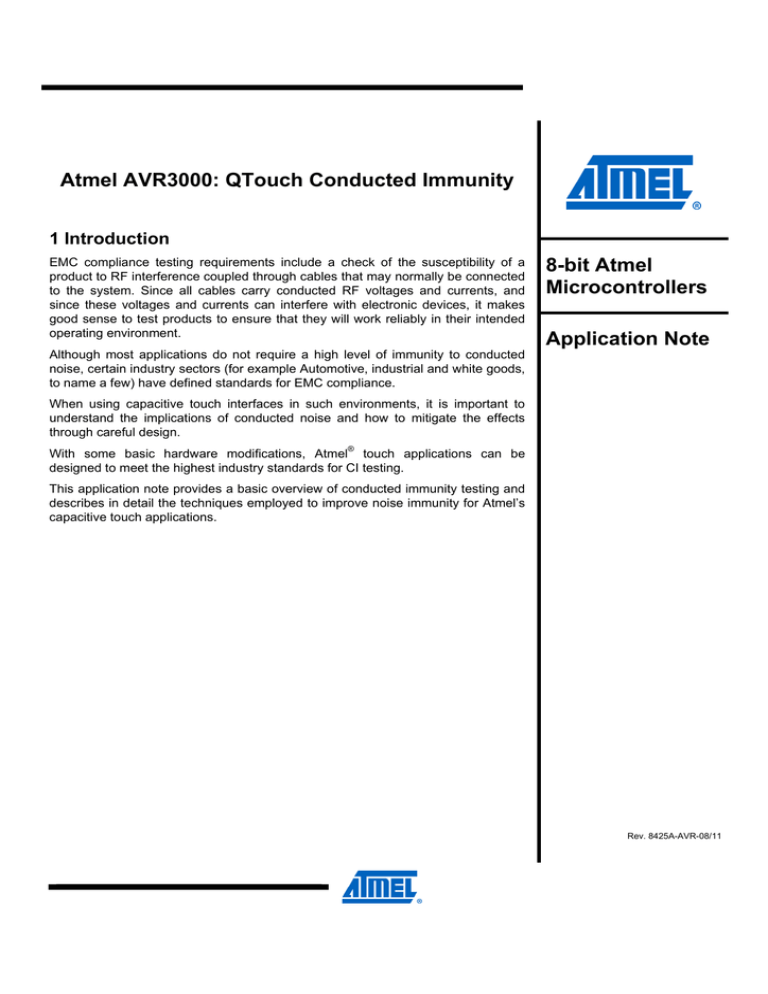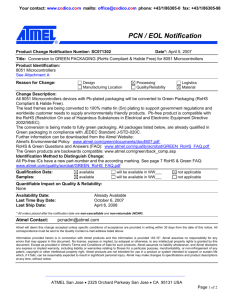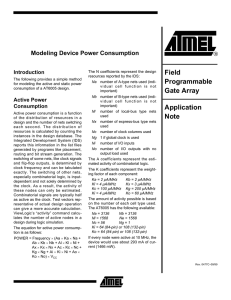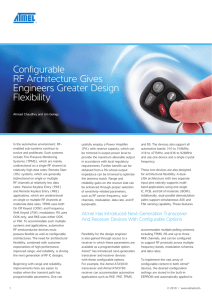
Atmel AVR3000: QTouch Conducted Immunity
1 Introduction
EMC compliance testing requirements include a check of the susceptibility of a
product to RF interference coupled through cables that may normally be connected
to the system. Since all cables carry conducted RF voltages and currents, and
since these voltages and currents can interfere with electronic devices, it makes
good sense to test products to ensure that they will work reliably in their intended
operating environment.
Although most applications do not require a high level of immunity to conducted
noise, certain industry sectors (for example Automotive, industrial and white goods,
to name a few) have defined standards for EMC compliance.
8-bit Atmel
Microcontrollers
Application Note
When using capacitive touch interfaces in such environments, it is important to
understand the implications of conducted noise and how to mitigate the effects
through careful design.
With some basic hardware modifications, Atmel® touch applications can be
designed to meet the highest industry standards for CI testing.
This application note provides a basic overview of conducted immunity testing and
describes in detail the techniques employed to improve noise immunity for Atmel’s
capacitive touch applications.
Rev. 8425A-AVR-08/11
2 Conducted immunity
Conducted RF immunity simply refers to a product’s immunity to unwanted ’noisy’ RF
voltages and currents carried by its external wires and cables. The source of this
unwanted noise can include RF transmitters, switched-mode power supplies and
other interconnected devices that have electronic activity in RF range.
Conducted noise will generally be in Common-Mode (CM) and appear across all
connecting cables to a device.
Capacitive touch applications are generally not affected by CM noise until human
interaction takes place. This is because the power supply lines maintain a stable
difference between VDD and GND and as no return path is provided to the noise
source reference (usually earth), the circuit functions normally.
Once human interaction takes place, however, the user’s finger now provides a return
path and effectively couples noise directly into the capacitive sensor. When this noise
reaches levels where normal filtering algorithms become ineffective, errors are
introduced into the touch measurement and the system becomes unreliable. This can
manifest itself by way of undetected touches, false touches or in some cases, a
complete system lock-up.
It is important therefore to understand the environment in which the touch application
is designed to operate in, and where appropriate apply suitable techniques to address
the effects of unwanted noise disturbances.
2
Atmel AVR3000
8425A-AVR-08/11
Atmel AVR3000
3 Testing requirements
3.1 EMC standards
The immunity test for conducted disturbances induced by radio-frequency fields is
defined by standard IEC/EN 61000-4-6 and is often called up as the basic test
method by immunity standards listed under the Electromagnetic Compatibility (EMC)
directive. The standard establishes a common reference and a set of testing methods
for evaluating the functional immunity of electrical and electronic equipment to
conducted noise.
3.2 Test criteria
CI testing involves injecting RF voltages or currents into each of the cables
associated with the equipment under test. The basic requirement for the test system
is to generate a modulated RF signal of sufficient amplitude, stepped over the
frequency range from 150kHz to 80MHz. The upper frequency range may be
extended by some product standards or customer specific requirements.
The tested frequency range is covered in number of small steps. At each step there is
a ’dwell period’ whilst the EUT (Equipment Under Test) is checked for performance
degradation.
According to Table 1 of IEC/EN 61000-4-6, the standard test levels are:
Test Level 1
1V rms
Test Level 2
3V rms
Test Level 3
10V rms
Test Level X
User specified
Test Level X is called an `open’ specification and is included to provide the flexibility
for a specification to be set by a product or generic standard committee if they feel it
is more appropriate for the type of equipment covered by their standard.
Test levels 1 and 2 are generally considered the minimum stress levels required for
conformance testing of products intended for domestic and commercial environments.
Test level 3 normally applies to industrial applications.
The above table values refer to the open-circuit test levels (e.m.f) of the unmodulated
noise signal, expressed in r.m.s. When applying the test, this signal is 80% amplitude
modulated with a 1kHz sine wave to simulate real-world environments.
3
8425A-AVR-08/11
Figure 3-1.
The IEC/EN 61000-4-6 test level is always specified for the unmodulated wave. For
example, a 3V r.m.s. test has a peak-to-peak voltage of 15.22V as shown in Figure
3-1.
3.3 Compliance criteria
The pass/fail criteria depend on the purpose and function of the product. It may also
be defined by customer expectations.
IEC/EN 61000-4-6 recommends four general classifications for evaluating the
performance of the equipment under test.
Class A – No significant degradation in operation or functionality is allowed.
Class B – Some degradation in operation may occur, but the product recovers once
the stress is removed without any operator intervention. No change in operating state
or loss of data occurs.
Class C – Operation of the EUT is affected and operator intervention is required to
recover normal operation. Again, no loss of data is permitted.
Class D – Unrecoverable loss of function or degradation of performance. Loss of data
may occur.
3.4 Noise injection methods
There are a number of alternative test transducers, described in IEC/EN 61000-4-6,
which can be used for inducing the RF noise signal into connected cables.
According to the standard the preferred approach is to use Coupling-Decoupling
Networks (CDN’s) to directly inject RF voltages into the cables under test. A CDN
requires the least power of all transducers and automatically and accurately controls
the injected source impedance, maintaining a reasonably accurate RF voltage into
the EUT’s cables.
Alternative methods such as Bulk Current Injection (BCI) and the Electromagnetic
Clamp (EM-Clamp) are also described, although it is important when using either of
4
Atmel AVR3000
8425A-AVR-08/11
Atmel AVR3000
these methods to closely follow the instructions set out in the standard. Incorrect
application of either technique can create a severe over-test situation which
would be unrealistic of most real life electromagnetic environments.
4 Improving noise immunity
With careful attention to sensor layout and some basic circuit modifications it is
possible to realize a touch solution using Atmel’s capacitive sense technologies that
meet the highest CI conformance requirements as specified in IEC/EN 61000-4-6.
4.1 Signal path impedance
Increasing the impedance of the signal path from the sense electrode to the touch
controller input can significantly improve immunity to conducted noise in applications
using Atmel AVR® QTouch®, Atmel AVR QMatrix and Atmel AVR QTouch-ADC
sensing methods. A larger series resistor in the ‘charge transfer’ path provides high
impedance to noise while maintaining the overall signal integrity.
Increasing the series resistor from a typical value of 1KΩ to about 100KΩ and
ensuring complete ‘charge transfer’ can typically improve noise immunity by a factor
of two or more. Depending on the noise disturbance in a given application an optimal
intermediate resistor value can be chosen to achieve the required level of noise
suppression while meeting other system design requirements such as power
consumption and response time.
QTouch, QMatrix and QTouch-ADC sensing methods are optimized for minimum
power. Adding a high value of series resistor will require an increased ‘charge
transfer’ time that increases capacitance measurement time, thereby increasing the
response time and power consumption. However, with a small increase in power
consumption, considerable improvement in Conducted Noise immunity can be
achieved. Refer to Section 4.1.4 in order to ensure proper tuning of the charge
transfer pulse when the series resistor is increased.
4.1.1 QTouch
In the case of QTouch, using a larger value of series resistor on the SNSK Port pin as
indicated in Figure 4-1 results in improved noise immunity.
Figure 4-1. Increasing series resistor for QTouch method.
A tm e l M C U
SNSK
In c r e a s e R s f r o m
1 K o h m to 1 0 0 K o h m
f o r im p r o v e d n o is e
im m u n it y
PB1
E le c tr o d e
Rs
Cs
PC1
SNS
R s – S e r ie s r e s is to r ,
1 K o h m t y p ic a l
C s – S a m p le c a p a c ito r ,
2 2 n F t y p ic a l
P B 1 – P o r tB b it1
P C 1 – P o r tC b it1
4.1.2 QTouch-ADC
For QTouch-ADC, using a larger value of series resistor on the port pin connected to
the sensor as indicated in Figure 4-2 results in improved noise immunity.
5
8425A-AVR-08/11
Figure 4-2. Increasing series resistor for Atmel AVR QTouch-ADC method.
Increase Rs from
1Kohm to 100Kohm
for improved noise
immunity
Atmel MCU
Touch
Button 0
PA0
Rs0
Touch
Button 1
Touch
Button 2
PA1
Rs1
PA2
Rs2
Touch
Button 3
Touch
Button 4
PA3
Rs3
PA4
Rs4
Touch
Button 5
PA5
Rs5
Rs – Series resistor,
1Kohm typical
PAn– PortA Pin ‘n’
4.1.3 QMatrix
In the case of QMatrix, using a larger value of the RY series resistor on the YA Port
pins as indicated in Figure 4-3 results in improved noise immunity.
Figure 4-3. Increasing series resistor for QMatrix method.
A tm e l M C U
S e n s o rs ,
X ,Y
R X 0
X 0
...
R X n
X n
Y 0 A
S e n so r
0 ,0
S e n so r
0 ,m
S e n so r
n ,0
S e n so r
n ,m
In c r e a s e R Y 0 to R Y m
fro m 1 K o h m to 1 0 0 K o h m
fo r im p r o v e d n o is e
R Y 0
im m u n ity
...
R Y m
Y m A
C S 0
...
C S m
Y 0 B
Y m B
R Y B 0
R Y B m
S M P
V re f
T y p ic a l
v a lu e s
R X : 1 K o h m
R Y : 1 K o h m
C S : 4 .7 n F
R Y B : 4 7 0 k
4.1.4 Tuning for proper charge transfer pulses
With the increased series resistor, the RC time constant formed in combination with
sensor capacitance will slow down the charge transfer settling process. In order to
obtain stable and repeatable results, it is important to ensure proper settling process.
For an overview of charge transfer pulses and method to observe good and bad
charge pulses using an oscilloscope, refer to the ‘Charge transfer’ section in Atmel’s
6
Atmel AVR3000
8425A-AVR-08/11
Atmel AVR3000
Touch Sensor Design Guide. In order to achieve good charge pulses, the firmware
parameter to control the charge transfer time should be increased.
For application specific devices this parameter will be identified in the relevant
datasheet.
When using the Atmel AVR QTouch Library, the QT_DELAY_CYCLES parameter
should be used so as to increase the ‘Charge cycle’ time for QTouch method. For the
case of Atmel AVR QMatrix, the QT_DELAY_CYCLES parameter should be used so
as to increase the ‘Dwell time’. For the case of QTouch-ADC for tiny40 device, the
library with a higher ‘csd’ value should be used. With QTouch-ADC for tiny20 device,
higher value of the DEF_QT_DELAY_CYCLES parameter should be used. For
additional information on these parameters, refer to QTouch Library User Guide. Also
refer to QTAN0062: QTouch and QMatrix Sensitivity Tuning for Keys, Sliders and
Wheels for Sensitivity tuning.
With a series resistor of 100KΩ, a ‘charge transfer’ time of 4us or higher is
recommended.
4.2 Sensor design considerations
Excellent immunity to CI noise can be achieved by having a good layout for capacitive
sense applications. Traces from the microcontroller input pins to the sense electrodes
should be kept as short as possible and electrode designs should be consistent with
the recommendations in Atmel Touch Sensor Design Guide.
For self-capacitance electrode configurations using QTouch and QTouch-ADC
sensing methods, additional improvements in noise immunity can be achieved by
adding ground loading, either in a planar way or by having a hatch ground plane
behind the sensor. The ground loading provides a low impedance noise path,
directing coupled noise away from the touch controllers input pins. Although this
approach is not recommended under the general sensor design guidelines because
of the effect on sensor gain, the SNR improvements achieved from ground loading
can far outweigh any reduction in touch sensitivity when operating in noisy
environments.
In most cases, loss of sensor gain due to the introduction of ground loading can be
compensated by careful sensitivity tuning.
For mutual-capacitance electrode configuration using QMatrix, ground loading does
not result in any additional improvement to noise immunity.
4.2.1 Ground loading planar construction
Ground loading for self-capacitance sensors is indicated in the Figure 4-4. The gap
between sensor and ground plane should be half the thickness of the overlying panel
T. This method is useful for single-sided PCB’s.
7
8425A-AVR-08/11
Figure 4-4. Ground flood, near to a sensor.
4.2.2 Ground loading, hatched ground plane behind the sensor
Figure 4-5 shows the arrangement of a hatched ground plane behind the sensor. The
left side image indicates the top side view and the right side image indicates the
bottom side view.
Figure 4-5. Hatched ground plane behind the sensor.
To balance the tradeoff between sensor gain reduction and noise suppression a 50%
mesh flood is recommended for most applications.
8
Atmel AVR3000
8425A-AVR-08/11
Atmel AVR3000
5 Conclusion
For the case of Atmel AVR QTouch, Atmel AVR QTouch-ADC and Atmel AVR
QMatrix methods, increased series resistor along with ‘charge pulse’ tuning provides
improved protection against conducted immunity noise. In the case of QTouch and
QTouch-ADC methods, additional improvement can be achieved by using ground
loading.
6 References
1. Touch Sensors Design Guide.
www.atmel.com/dyn/resources/prod_documents/doc10620.pdf.
2. Atmel AVR QTouch Library User Guide.
www.atmel.com/dyn/resources/prod_documents/doc8207.pdf.
3. QTAN0062: QTouch and QMatrix Sensitivity Tuning for Keys, Sliders and
Wheels.
www.atmel.com/dyn/resources/prod_documents/QTAN0062.pdf.
9
8425A-AVR-08/11
7 Table of contents
1 Introduction ...................................................................................... 1
2 Conducted immunity ....................................................................... 2
3 Testing requirements ...................................................................... 3
3.1 EMC standards.................................................................................................... 3
3.2 Test criteria.......................................................................................................... 3
3.3 Compliance criteria.............................................................................................. 4
3.4 Noise injection methods ...................................................................................... 4
4 Improving noise immunity .............................................................. 5
4.1 Signal path impedance........................................................................................ 5
4.1.1 QTouch...................................................................................................................... 5
4.1.2 QTouch-ADC............................................................................................................. 5
4.1.3 QMatrix...................................................................................................................... 6
4.1.4 Tuning for proper charge transfer pulses................................................................... 6
4.2 Sensor design considerations ............................................................................. 7
4.2.1 Ground loading planar construction........................................................................... 7
4.2.2 Ground loading, hatched ground plane behind the sensor ........................................ 8
5 Conclusion ....................................................................................... 9
6 References........................................................................................ 9
7 Table of contents ........................................................................... 10
10
Atmel AVR3000
8425A-AVR-08/11
Atmel Corporation
2325 Orchard Parkway
San Jose, CA 95131
USA
Tel: (+1)(408) 441-0311
Fax: (+1)(408) 487-2600
www.atmel.com
Atmel Asia Limited
Unit 01-5 & 16, 19F
BEA Tower, Milennium City 5
418 Kwun Tong Road
Kwun Tong, Kowloon
HONG KONG
Tel: (+852) 2245-6100
Fax: (+852) 2722-1369
Atmel Munich GmbH
Business Campus
Parkring 4
D-85748 Garching b. Munich
GERMANY
Tel: (+49) 89-31970-0
Fax: (+49) 89-3194621
Atmel Japan
9F, Tonetsu Shinkawa Bldg.
1-24-8 Shinkawa
Chou-ku, Tokyo 104-0033
JAPAN
Tel: (+81) 3523-3551
Fax: (+81) 3523-7581
© 2011 Atmel Corporation. All rights reserved.
®
®
®
Atmel , Atmel logo and combinations thereof, QTouch , AVR , AVR logo and others are registered trademarks or trademarks of Atmel
Corporation or its subsidiaries. Other terms and product names may be trademarks of others.
Disclaimer: The information in this document is provided in connection with Atmel products. No license, express or implied, by estoppel or otherwise, to
any intellectual property right is granted by this document or in connection with the sale of Atmel products. EXCEPT AS SET FORTH IN THE ATMEL
TERMS AND CONDITIONS OF SALES LOCATED ON THE ATMEL WEBSITE, ATMEL ASSUMES NO LIABILITY WHATSOEVER AND DISCLAIMS
ANY EXPRESS, IMPLIED OR STATUTORY WARRANTY RELATING TO ITS PRODUCTS INCLUDING, BUT NOT LIMITED TO, THE IMPLIED
WARRANTY OF MERCHANTABILITY, FITNESS FOR A PARTICULAR PURPOSE, OR NON-INFRINGEMENT. IN NO EVENT SHALL ATMEL BE
LIABLE FOR ANY DIRECT, INDIRECT, CONSEQUENTIAL, PUNITIVE, SPECIAL OR INCIDENTAL DAMAGES (INCLUDING, WITHOUT LIMITATION,
DAMAGES FOR LOSS AND PROFITS, BUSINESS INTERRUPTION, OR LOSS OF INFORMATION) ARISING OUT OF THE USE OR INABILITY TO
USE THIS DOCUMENT, EVEN IF ATMEL HAS BEEN ADVISED OF THE POSSIBILITY OF SUCH DAMAGES. Atmel makes no representations or
warranties with respect to the accuracy or completeness of the contents of this document and reserves the right to make changes to specifications and
product descriptions at any time without notice. Atmel does not make any commitment to update the information contained herein. Unless specifically
provided otherwise, Atmel products are not suitable for, and shall not be used in, automotive applications. Atmel products are not intended, authorized, or
warranted for use as components in applications intended to support or sustain life.
8425A-AVR-08/11






